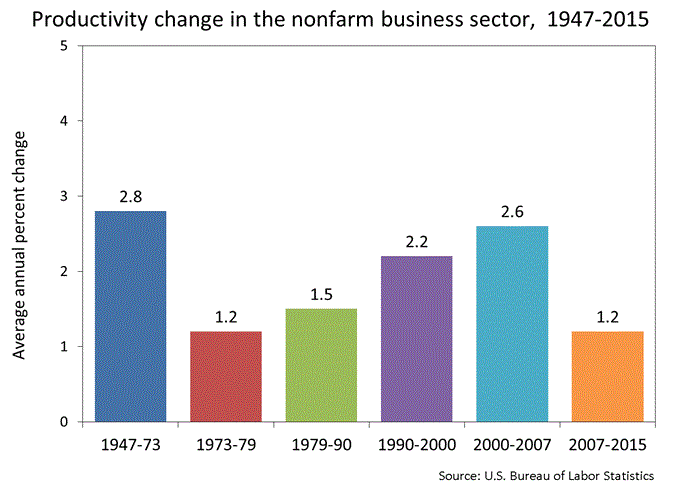Over the past 50 years, technology has ushered in an enormous amount of efficiency to the workplace that have increased productivity and improved inter-organization communication. However, according to the Bureau of Labor Statistics productivity from 2007-2015 actually went down, breaking the trend of continual improvements in productivity starting in the 1970s (see the graph below). Although companies have continued to implement new technologies in the workplace, the improvements to productivity seem to be diminishing. Why would this be?
 To answer this question, we turn to a theory created in the 1980s called Metcalfe’s Law. According to the law, the value of a network – or for the sake of understanding, any communication technology – increases with the square of the number of users. So for example, one telephone is worthless. Two telephones are worth a slight amount. A million telephones are incredibly worth while, because now there are millions of people who can call each other. Another postulation of Metcalfe’s Law is that as the difficulty or cost of communication in a network decreases, the number of interactions increases exponentially, along with the time required to process them. For example, in the 1990s business executives might receive or send a couple of emails a day, but by the 2000s – when email became commonplace – an executive might receive 100+ emails a day. Despite the improved accessibility and efficiency, the system or network inundates the executive with emails and thus reduces or eliminates the efficiency through unnecessary communications and wasted time. This problem may be at the reason for the drop in productivity today.
To answer this question, we turn to a theory created in the 1980s called Metcalfe’s Law. According to the law, the value of a network – or for the sake of understanding, any communication technology – increases with the square of the number of users. So for example, one telephone is worthless. Two telephones are worth a slight amount. A million telephones are incredibly worth while, because now there are millions of people who can call each other. Another postulation of Metcalfe’s Law is that as the difficulty or cost of communication in a network decreases, the number of interactions increases exponentially, along with the time required to process them. For example, in the 1990s business executives might receive or send a couple of emails a day, but by the 2000s – when email became commonplace – an executive might receive 100+ emails a day. Despite the improved accessibility and efficiency, the system or network inundates the executive with emails and thus reduces or eliminates the efficiency through unnecessary communications and wasted time. This problem may be at the reason for the drop in productivity today.
According to research conducted at Bain & Company, employees are spending way too much time processing e-communications and attending/scheduling meetings. The average manager works 47 hours per week, and he or she devotes 21 hours to meetings and another 11 hours to e-communications. That leaves the manager with less than 15 hours a week to do other work, and when you count “unproductive time” between meetings or processing emails, the manager is actually left with less than 6.5 hours per week of uninterrupted time.
So what’s the answer to this problem? How can companies make smart decisions when it comes to implementing new technologies? Well, the researchers at Bain have two factors organizations should consider when assessing technology investments:
- What impact will the new technology have on organizational time? Does the technology allow people to do more in less time, or does it just make work and collaboration easier? Companies should prioritize technologies that reduce the cost of interactions but also reduce the time needed. Any technologies that reduce the cost but do not themselves save time are probably bad investments.
- Could better rules eliminate the need for further investment? If the considered technology is just a workaround for bad behavior or poor procedures, then the company should consider alternative methods for changing the dysfunctional behavior. That might mean rethinking the company culture, implementing new management practices, or creating new guidelines and measurements for worker productivity.

Recent Comments